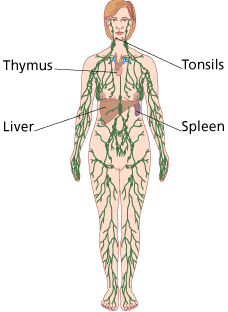
Trisoma®
Lymphatic Drainage Therapy
 Manual lymphatic drainage (MLD) and mechanical drainage are hospital prescribed and insurance accepted therapy for lymphedema and other disorders.
Manual therapy is useful not only for edema, but general wellness, including
lymphedema (especially following breast cancer mastectomy surgery),
rheumatoid arthritis,
fibromyalgia,
chronic venous insufficiency,
lipedema
[1]
and
holistic skin care.
[10]
According to the Cleveland Clinic, mechanical methods using pumps and pressure sleeves can help lymph move,
but we have received many anecdotal reports of pain and possible vessel injury caused by mechanical methods.
Manual lymphatic drainage (MLD) and mechanical drainage are hospital prescribed and insurance accepted therapy for lymphedema and other disorders.
Manual therapy is useful not only for edema, but general wellness, including
lymphedema (especially following breast cancer mastectomy surgery),
rheumatoid arthritis,
fibromyalgia,
chronic venous insufficiency,
lipedema
[1]
and
holistic skin care.
[10]
According to the Cleveland Clinic, mechanical methods using pumps and pressure sleeves can help lymph move,
but we have received many anecdotal reports of pain and possible vessel injury caused by mechanical methods.
Lymphatic drainage massage is generally safe, but
...ask your healthcare provider if you have any contraindications, including heart condition, kidney failure, blood clots or thrombosis, infection.
Manual Lymphatic Drainage Bodywork
...resembles swedish massage effleurage techniques, frequently with oil, and may include passive stretching. Because much of the lymphatic system is in the abdomen, treatment may include abdomen, extremities and even the head; while the back has few lymphatic vessels near the skin. In most cases clients can learn to perform some self-massage; remember that every time one rubs a towel along the extremities, this can affect lymph and venous blood flow, so moving the towel proximally (toward the heart) is along the direction of flow. Lymphatic vessels and blood veins have one-way valves, so moving distally is against the flow, and may affect the valves.
Human circulation systems
... include the cardiovascular system. However humans also have three other important circulatory systems: craniosacral, glymphatic and lymphatic, which has peripheral and meningeal divisions. The peripheral lymphatic system is the target for manual lymphatic bodywork.

Lymphatic system is analogous to a sewer
Whereas the blood circulatory system could be analogous to a water system of a city, the lymphatic system is analogous to sewer system components including inlets, piping, valves, lift stations and treatment facilities, which can become easily overloaded during a "health storm", such as injury or infection. The lymphatic system is a branched system throughout the body which transports lymph through vessels, ducts and nodes, to process centers and for elimination. If the system is not functioning well, the water can fill in the vessels (or "pipes"), overflow into the surrounding tissue (or "street"), and clog the lymph nodes. Complications occur when the system is overloaded with toxins (just as sewers may have oil and debris) or when a person is injured or sick.
Most organs of the body have lymphatics
Lymphatics have been described in most organs of the body, including thyroid gland, thymus, tongue, adrenals, kidneys, urinary bladder and even the cranial meninges. [2] The peripheral lymphatics are structured in two layers, comprising superficial and deep systems separated by the deep fascia. The superficial lymphatic system is particularly significant for understanding the pathology of lymphedema. The functions of the lymphatic vasculature are much broader than generally thought, and are much more than a sewer system. Lymphatic research will have many interesting and surprising aspects to offer in the future. [21]
The human body performs lymphatic drainage
...primarily during skeletal muscle contractions, and that is why frequent walking and activity, and lymphatic drainage helps with edema [3]. Full gait body mechanics, including calves and quads and glutes, will help prevent traffic jams of fluid. This is why sedentary and post surgical scenarios that lack pressure differential in the intravascular and extravasated fluid environment will contribute to edema and other lymph issues. Lymphangions and even inspiration (breathing) helps, but without active body movement, the interstitial fluid, lymph capillaries, vessels and nodes will not clear as well.
Neuromedicine researchers at University of Rochester Medical Center propose that the glymphatic/lymphatic system acts as a cornerstone in signaling between the brain and body and much remains to be studied regarding the evidence for cross talk among the glymphatic system, cardiovascular system, gastrointestinal tract, and lymphatic system [4].
"Life is like a bicycle. You don't fall off until you stop pedaling." - Dr. Travell
History
Hippocrates described ‘white blood’ in the body in the year 5 BCE, and this is considered to be the oldest account of the lymphatics. The first discovery of the lymphatics in academia is credited to Gaspare Aselli and his canine study in 1622 was published posthumously in 1627 Now it is understood that lymphatic vascular system is much more than just a sewer, and lymphatics develop in all organs, with some specific exceptions.
References
2. Null M, Arbor TC, Agarwal M. Anatomy, Lymphatic System [Updated 2023 Mar 6]. In: StatPearls [Internet]. Treasure Island (FL): StatPearls Publishing; 2024 Jan-. Available from: https://www.ncbi.nlm.nih.gov/books/NBK513247/
Affiliations
1 UPMC/Pinnacle
2 Wake Forest University School of Medicine
3 University of Pennsylvania
(Return to Reference 2 in text)
3. Guyton AC, Hall JE. Guyton and Hall Textbook of Medical Physiology. Philadelphia: Saunders; The microcirculation and lymphatic system: capillary fluid exchange, interstitial fluid, and lymph flow; pp. 177–186. (Return to Reference 3 in text)
4. Hablitz LM, Nedergaard M. The Glymphatic System: A Novel Component of Fundamental Neurobiology. J Neurosci. 2021 Sep 15;41(37):7698-7711. doi: 10.1523/JNEUROSCI.0619-21.2021. PMID: 34526407; PMCID: PMC8603752. (Return to Reference 4 in text)
10. Terrance Bonner Mastering Holistic Manual Lymphatic Drainage skininc.com Apr 3rd, 2024 (Return to Reference 10 in text)
20, 21. Akira Shinaoka & Hiroo Suami Anatomy of the Lymphatic System and Structural Changes in Lymphedema of the Extremities Chapter First Online: 10 May 2022 pp 7–14 (Return to Reference 20 in text) (Return to Reference 21 in text)
Images
1.
Diagram of human lymphatic system
from
Wikipedia
(Return to Image 1 in text)
2.
Paul Svacina,
Ellwood, 2008.
(Return to Image 2 in text)
3.
& 4.
Courtesy of freeimages.co.uk
(Return to Image 3 in text)
(Return to Image 4 in text)